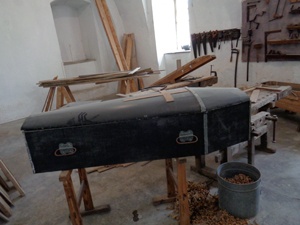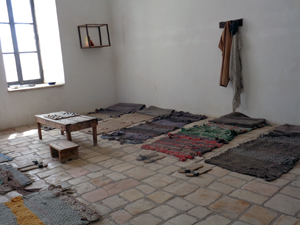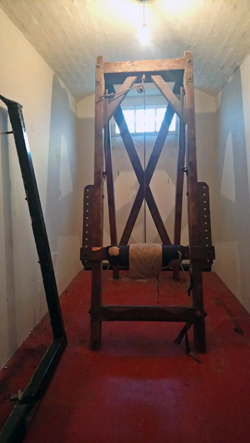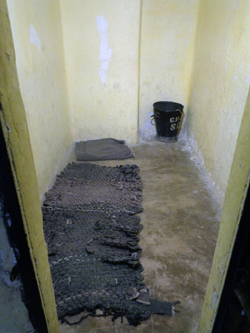By Deborah Rubin Fields

JERUSALEM — Two jails-separated by thousands of miles-reflect two 20th century struggles for independence. The irony lies in the fact that these two geographically distant fights for freedom were against the same harsh ruler and jailer, the British Crown. Today, neither Israel’s Central Prison Jerusalem (C.P.J.) nor Northern Ireland’s Crumlin Road Gaol in Belfast house inmates, but even as museums, their powerful histories continue to echo in the halls and cells.
What was the Jewish fight for independence about? As many know, in the early 20th century, an increasing number of world Jewry wanted to establish a Jewish state in historic Palestine. This Jewish state would be the legal and political guardian of the interests of the Jewish people. The 1917 Balfour Declaration (which read “His Majesty’s government looks with favor upon the establishment in Palestine of a national homeland for the Jewish people”) had initially given Jews tremendous hope. But as the British Mandatory Period (which began in 1920) continued, this hope turned into tremendous frustration, as the British in Palestine refused entry to shipload after shipload of Holocaust survivors. This action brought tensions to a new high. In an effort to oust the British from Palestine, underground Jewish fighters took to opposing British rule-any way they could.
What were the Irish seeking? Very briefly put, some, but not all Irish wanted a state of their own, independent of the British. At times, the dispute cast Catholics against the Protestants. But the more significant aspects of this prolonged struggle were the cultural, social and historical factors which pinned the more privileged against the less privileged. From 1919-1921, there was a guerrilla conflict known as the Irish War of Independence in which government-sanctioned British forces in Ireland fought the Irish Republican Army (IRA). Yet, over the years, violence erupted, even after Ireland became an independent republic in 1948. This violence was in large part related to the fact that Northern Ireland remained under British control. In 1969, an extended period known as The Troubles began in Northern Ireland. It continued until the late 1990s when tired and scarred by so many years of civil and military violence and governmental neglect, a truce was worked out between all sides.
Both the Jerusalem and the Belfast jails housed criminal and political prisoners. Needless to say, as the struggles for independence intensified, the number of political prisons rose. Crumlin was meant for single cell accommodation, but during The Troubles up to three prisoners might have occupied a single cell.

At both prisons, the prison staff put prisoners (except for those with enforced hard labor or those entitled to special treatment) to work at providing essential services to other inmates and British governmental employees. At Crumlin, prisoners worked at the laundry, the tailor and the shoemaker shops. The laundry even served the local community. In Jerusalem, the prisoners labored in a variety of workshops, including the carpentry shop. There they built coffins for British soldiers. A bit morbid, but when there was an increased order for coffins, the Jewish prisoners were able to gauge how the conflict was proceeding outside.

In Jerusalem, most inmates slept together in large cells on thin, woven floor mats. While Jews and Arabs had been housed together at the beginning of the Jerusalem prison operation, this policy changed over time. Moslem prisoners had their prayer area, as did the Jewish prisoners. Especially at the end of the British Mandate period, Arab and Jewish prisoners came to such blows that many were hurt and Avraham Shivili, the Jewish medic was killed. While Crumlin separated male, female and child prisoners, they did not separate fighting factions. The in-house hostilities reached a peak when a terrorist bomb detonated in the dining room. The result-two dead prisoners and repeated violent incidents until the jail finally closed.

If you thought whipping was something done only by cruel slave owners or by the Nazis, think again. Flogging was used as punishment in both jails. In Jerusalem, the prison regulation book states that prisoners may receive up to 24 lashes, in Crumlin up to 36 strokes. It was apparently carried out both privately and publicly with other prisoners watching. While both facilities imposed solitary confinement for relatively short periods of time, in the Jerusalem facility, prisoners greatly suffered from lice and bed bugs. Jailers likewise reduced food rations for those in isolation.
The British wanted to prove they were the boss, and a boss who would not relinquish control. Thus, sentencing for what the British administration defined as crimes was sometimes extremely arbitrary and heavy-handed. For example, the Belfast trial of Turkish Jew Eddie Cullens (who was neither Irish nor British, but a naturalized American citizen) resulted in his being sentenced to death on the basis of circumstantial evidence for a murder he most likely did not commit. In one Jerusalem trial, Moshe Barazani, a Jew was given the death sentence for bearing arms (he had a grenade in his pocket) and conspiracy to murder. In neither case was it shown these men had killed anyone.
Furthermore, in an empire which for centuries has used the phrase “G-d Save the King,” the bodies of the Belfast prisoners who received the death sentence were customarily not treated with religious respect. For instance, Crumlin Gaol officials carried out 17 executions. The bodies were buried within the prison compound in unconsecrated ground, against the back wall beside the prison hospital. Only two of the executed prisoners were re-interred and buried elsewhere.
Political prisoners were keen to return to the fighting. Hence, there were breakouts in both the Belfast jail and the Jerusalem jail. On November 17, 1971, nine republican (those believing all of Ireland should be an independent republic) prisoners known as the ‘Crumlin Kangaroos’ escaped. Less than a month later, three more republican prisoners escaped. In Jerusalem, in 1948, 12 prisoners from two fighting groups managed to escape by means of a tunnel built under one of the beds.
Even before the end of Northern Ireland’s “Troubles,” the British decided it was in their best interest to close the jail. The closure, however, did not come until 1996. Interestingly, the final execution in that facility was conducted years earlier in 1961.
The story was different in Jerusalem. Those Jewish fighters who had been condemned to hanging did not have their sentences carried out in Jerusalem. Jerusalem had achieved a Jewish majority, so as a safety measure, the British hung Jewish prisoners (a total of nine men) in the Arab town of Acre. There, the last song they all sang was “HaTikvah.”
Arab prisoners were also hung in Acre. Only in the late summer of 1947-when faced with mounting Jewish opposition (some say especially after the Irgun hung two British sergeants) and mounting financial burdens-did the British government end the death penalty in Palestine and vote to evacuate Palestine.
Israel became an independent state on May 14, 1948. British Mandatory rule ended at midnight of that day. The Northern Ireland agreement left the UK in charge. Northern Ireland residents, however, have finally been able to focus on re-building their cities and towns. The Jerusalem facility opened as a museum in 1991. The Belfast facility opened as a museum in 2012. The museums remind visitors how tenuous is this thing we call independence.
*
SIDEBAR: Two testimonies about life in solitary confinement in Central Prison Jerusalem:

“…in the solitary confinement cell we encountered the many animal inhabitants of the prison; innumerable fleas many of them more ancient than any of the prisoners, they probably had the honor of knowing the Turks…solitary confinement is a small room…a prison within a prison. It is a dark gloomy cage, not a drop of light can pierce the darkness….
The air is damp, the walls and floor so cold that one cannot sit-rather we have to stand or pace back and forth….
Usually the period of time spent in solitary confinement is marked by cuts in the food ration’ you get only bread and water…that is how we were punished.” — May 1946 testimony of Gideon Pelee
“They tied my hands with a metal chain to one of the door’s grids, brought me a bucket of water, a night pot for my sanitary needs and then went away….” — Testimony from Mati Shmuelevitz, circa 1944
*
Deborah Rubin Fields is a features writer based in Jerusalem, Israel.
Pingback: Two incarcerates: One tough jailer - San Diego Jewish World - Bed Bugs Heat Treatment